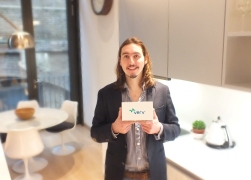Moving the connected home beyond ‘because we can’

Peter Davies, CEO of GreenRunning
Question One: Did you know the smart home means that your fridge will be able to order milk?
Question Two: Do you care?
Many connected home devices were built ‘because we can’. However, we should be looking beyond this, says Peter Davies, CEO of GreenRunning.
Instead, he says, let me ask:
- Would you care if your elderly relative didn’t put the kettle on as she has always does?
- Would you care if you’d left the oven on?
- If you manufactured fridges, would you care if the energy signatures could advise about real-world performance and pre-alert you (and your customer) ahead of breakdowns?
- If you were an insurer, would you care about boosting home security and providing more accurate quotes?
I would. The connected home needs to move from ‘because we can’ to ‘because we care’.
Straight to source
This sounds like a lot of data points, and collecting data from every appliance in the home wouldn’t be smart.
Instead, we should look for the common denominator: energy. And now, new technology is making new things possible.
Some point to smart meters and the resulting software as great progress. And it’s true that having data every few seconds can enable more informed decisions about energy usage. But how smart is that really?
The devil is in the detail, and detail comes from granularity. New things become possible when you talk about microseconds, rather than seconds.
Every electrical device has a unique signature. If sampled at seconds, they will be lumped together. When you zoom in to microseconds though, they are distinct. So much so that, even with multiple devices switched on, it’s possible to identify them.
You can tell the toaster from the fridge, the TV from the dishwasher, the washing machine from the dryer. And you can know exactly when each one is on.
It would take months for a user to sift through the data though. The value lies in real-time insights, and for that, the only option is machine learning.
A smart home indeed
At this level, energy data isn’t even about energy anymore. Sure, you can save money by seeing, in real-time, your biggest energy-draining appliances. But this data transcends the energy conversation.
Think of safety and security. If an elderly person fails to use the kettle for their morning cuppa, relatives could be alerted. If a teenager forgets to switch off hair straighteners, an app could recognise that signature and send an alert. Or what about that common dread that you’ve left the oven on? Banished forever.
Then there’s security: When the house is meant to be empty, you could be told if the lights are turned on.
Or – back to money saving – this data can tell you when appliances are becoming inefficient or are about to break – letting you avoid coming home to a freezer full of spoiled food and water damage. It could even work out which replacements are likely to offer the best return on investment based on your usage habits. It’s data that can make your home smarter – and cheaper.
The data doesn’t just give insights on the appliances. In the future, a complex understanding of a person’s behaviour pattern could even help show early signs of health issues such as dementia, or other behaviour-changing illnesses.
That’s a smart home, all enabled by energy data while having very little to do with your electric bill. It’s a smart home that cares for its inhabitants.
A more connected world
Third parties can also use it to improve their offerings.
In the insurance industry, appliance usage behaviour could be used to validate claims or warranties. And consumer usage could be used to price policies more accurately and competitively.
Of course, data privacy and security will be key. Only technology that takes security threats seriously will make a success of the smart home.
‘Because we can’ is no justification for introducing new home technology. We have to make technology that works because we care about the wellbeing of our families and property. Because we care about saving money. Because manufacturers, insurers and other third parties care about creating the best possible customer experience.
It’s still early days for the connected home market, but the technology already exists. Let’s make it actually smart.
The author of this blog is Peter Davies, CEO of GreenRunning
Comment on this article below or via Twitter @IoTGN
